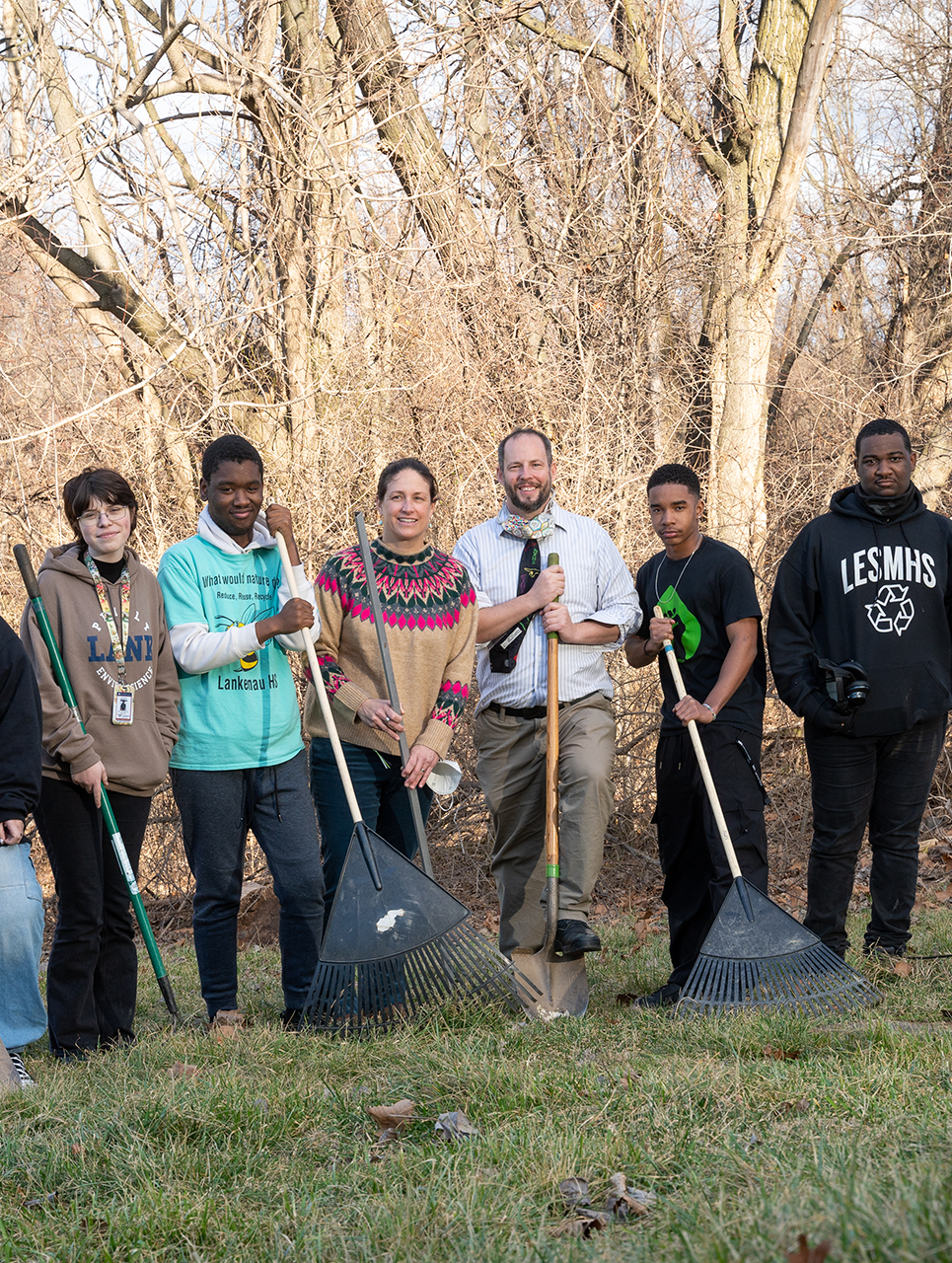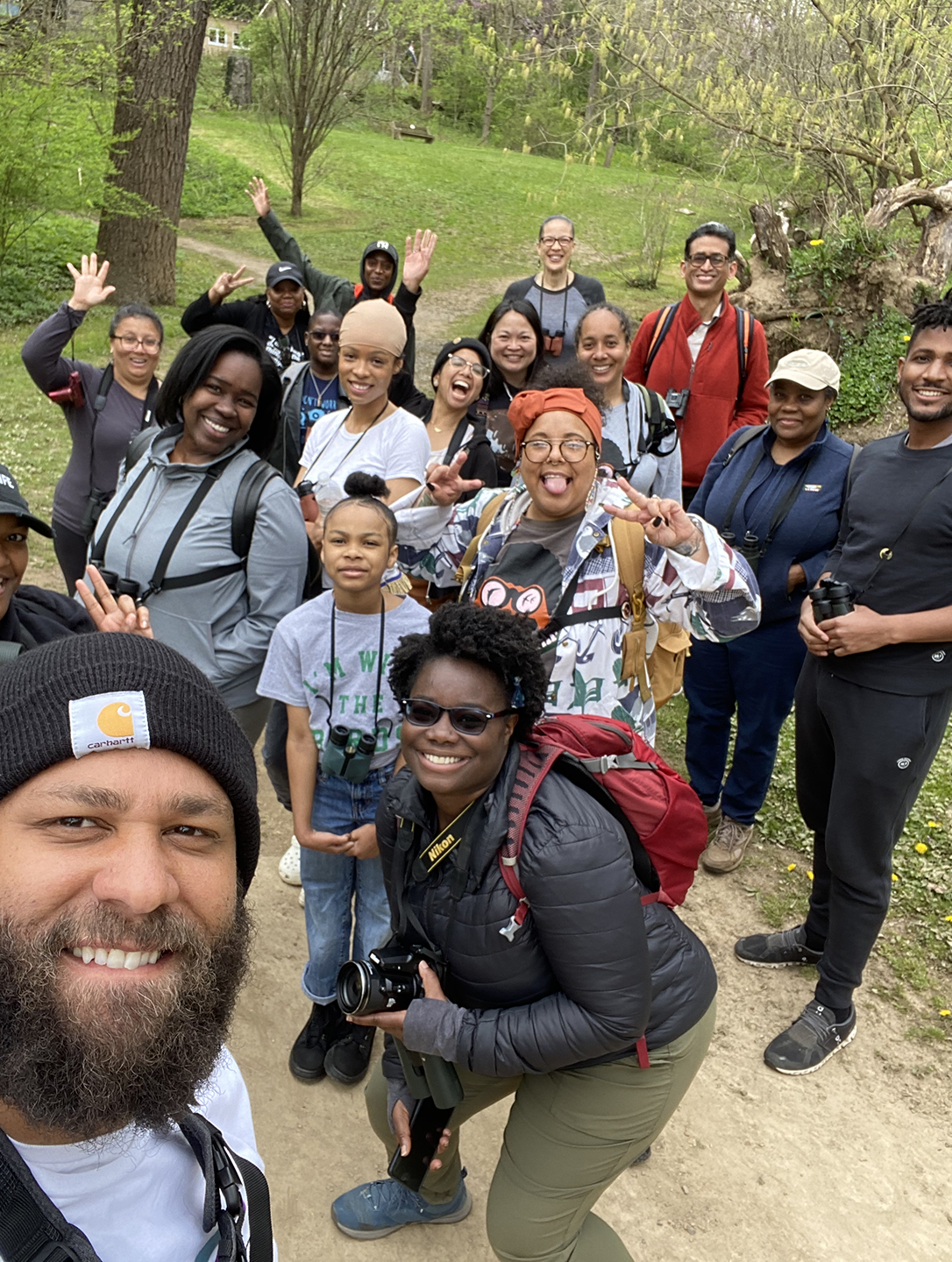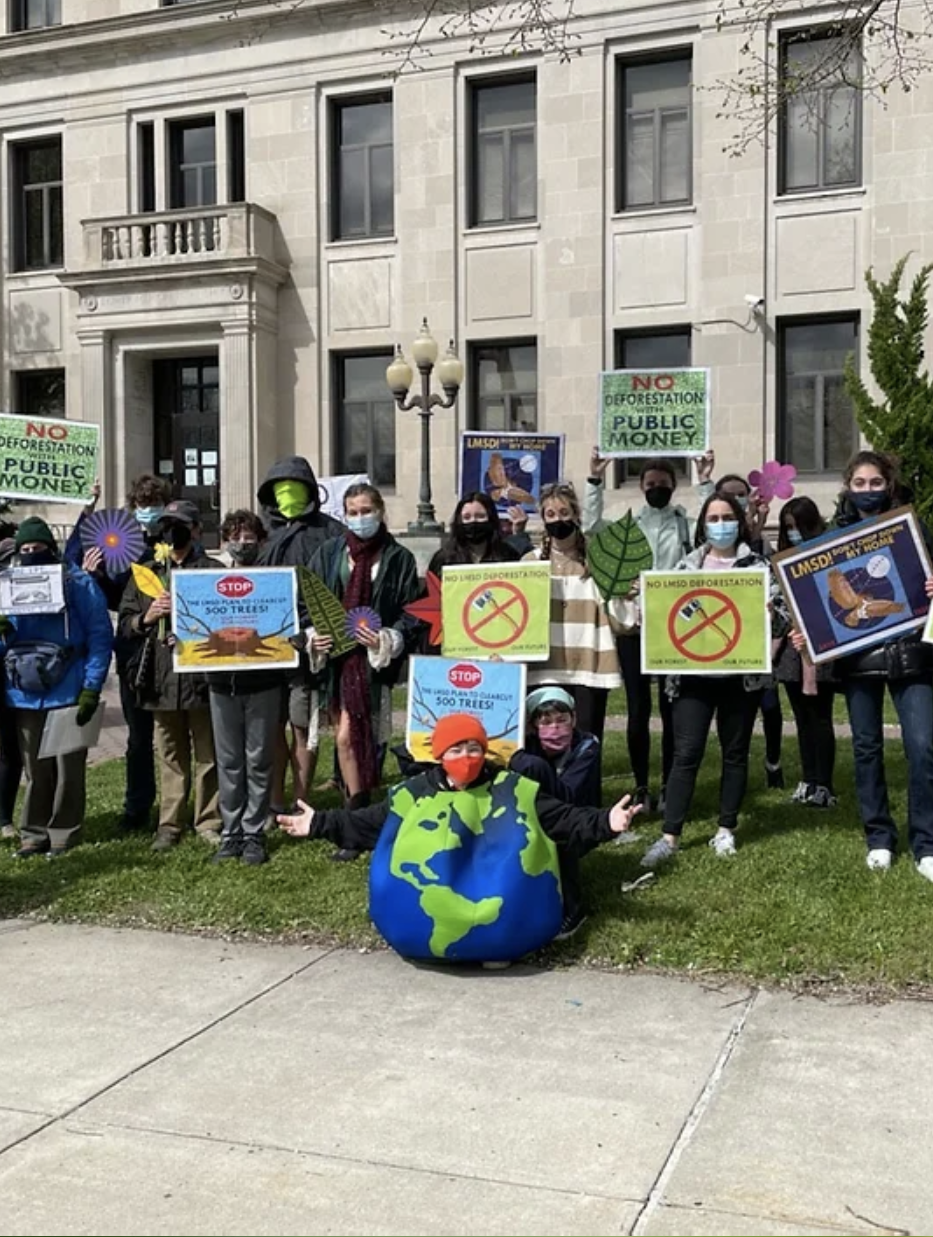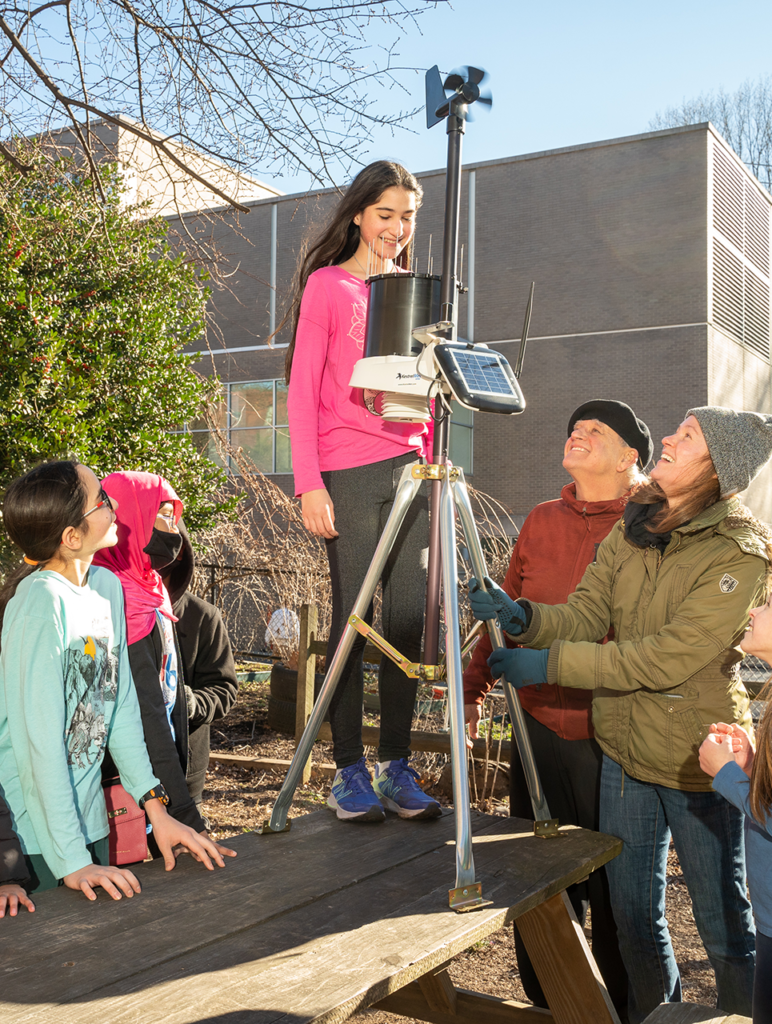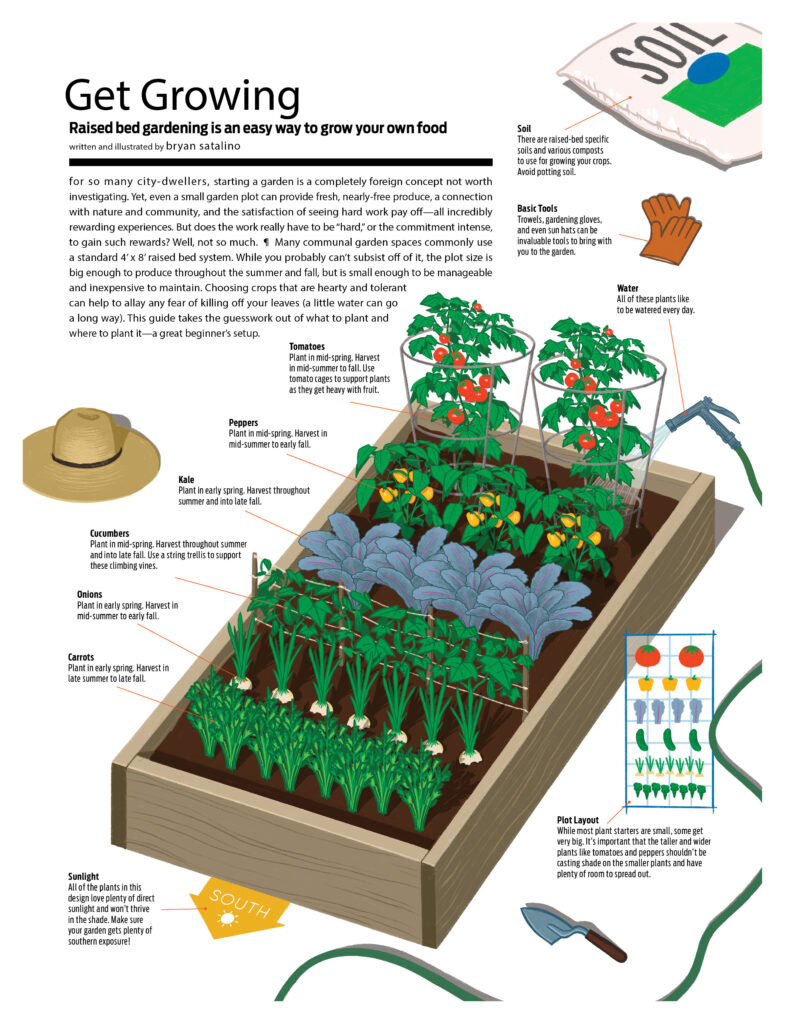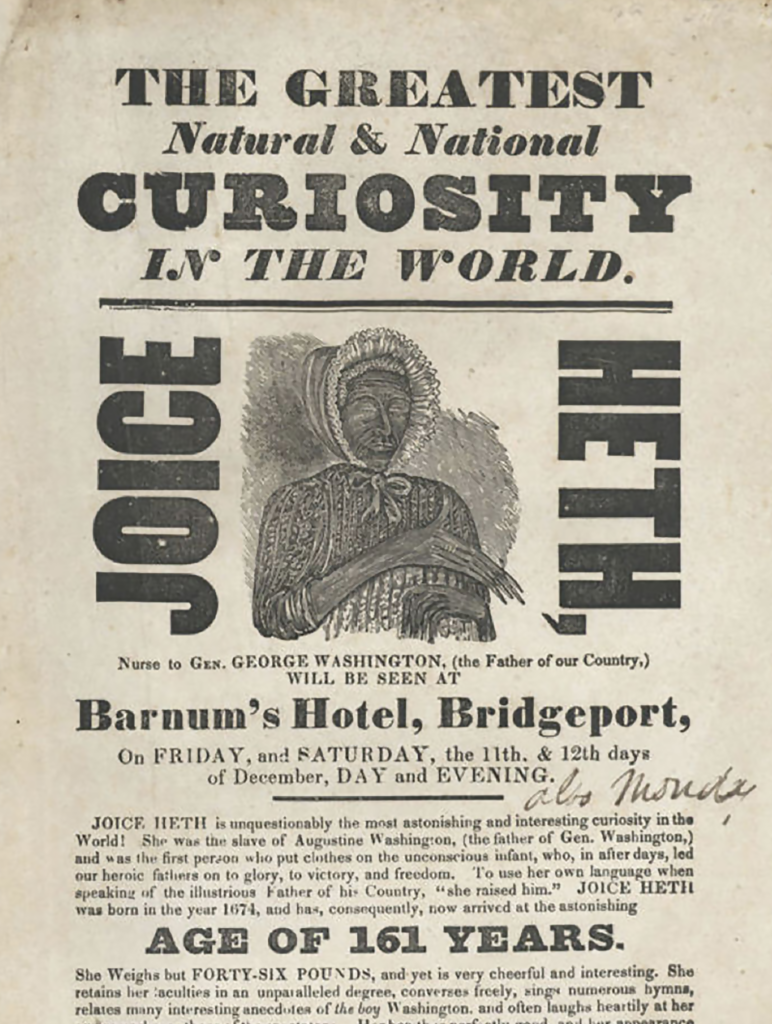In his classroom at Lankenau High School, veteran teacher Matthew VanKouwenberg points out to his students the connection between average daily temperatures across Philadelphia and tree canopies, noting that the lack of tree cover can leave some neighborhoods — often poor, often majority-minority — overheated in summer. VanKouwenberg, who teaches chemistry and environmental science at the 350-student magnet school in Northwest Philadelphia, takes it a step further, telling students that these discrepancies might make them and their relatives more susceptible to heat exhaustion or getting sick, or force them to pay higher costs to keep their homes livable. He teaches them how historical practices like redlining have contributed to environmental injustice. And then he asks them how they can help change it.
“It ignites this righteous anger,” VanKouwenberg says. “They should be mad about it.”
Rather than simply teaching students about climate change, climate injustice and the forces shaping their future, VanKouwenberg and some of his colleagues across the school district are attempting to motivate young Philadelphians to be agents of change. If anyone is going to address these colliding ecological and environmental crises, they are.
“You don’t have to passively accept what’s been given to you,” he says. “Don’t wait around until you feel like you have the power. Let’s empower you to take control of it.”
The climate change and sustainability curriculum is still in its infancy in Philadelphia public schools.
The seeds for the curriculum were sown in 2014, when the School District of Philadelphia’s environmental director, Francine Locke, returned from a conference on sustainability and asked for permission to develop a full-fledged sustainability program. Alongside Megan Garner, the district’s sustainability manager, she looked at what large school districts around the country were doing. Some had programs in place to limit energy consumption or waste, but few had a demonstrated plan to educate students about sustainability and climate change.
“As a school district, we have a responsibility to not just make operational changes, but also in a very meaningful way incorporate sustainability into the curriculum,” Garner says.

For inspiration, Garner and Locke, who is now the chief sustainability officer for Delaware County, turned to Greenworks, the City’s long-term sustainability framework, for ideas about educational programming and community engagement. They also looked to the National Wildlife Federation, whose Ranger Rick character was a staple in childhood environmental education for Garner and many others, and adopted portions of its Eco-Schools USA program for hands-on learning about the environment. In the Cloud Institute for Sustainability Education they found the third important element of what would become the school district’s approach to climate change and environmental education: the education for sustainability curriculum, which works with teachers to help inspire students to create change.
“It’s about education for a sustainable future and for sustainable development,” Garner says. “It’s more for sustainability than about sustainability.”
That emphasis is important. The district’s goal was to develop a curriculum that teaches students the analytical skills, including critical thinking and what Garner calls “systems thinking,” that will give them the power to seek solutions to the environmental and sustainability challenges that will shape their futures.
“We don’t want anybody to feel hopeless,” Garner says. “We want people to feel hopeful and start thinking about solutions. What are our barriers and how do we overcome those barriers?”
In collaboration with Fairmount Water Works and Ellen Schultz, its associate director for education, the school district has begun giving teachers the tools they need to deliver a curriculum called Understanding the Urban Watershed. Nearly a decade in the making, the curriculum teaches students from fourth grade through high school about the city’s water systems — from stormwater management to drinking water and everything in between — and what they can do to be stewards for the watershed and advocates for climate change action. Schultz says this year’s effort will reach about 40 educators across 22 district schools.
Garner is also leading monthly climate-related professional development sessions for teachers, exploring issues such as climate justice and the role that trees play in shaping the city’s environment. At a recent session, green schoolyards took center stage, tying into the school district’s upcoming launch of a greenscapes guide to help schools navigate the sustainability process. Over the past five years, roughly 400 teachers have participated in at least one such session, Garner says.
But while climate change education is a requirement for students across all grade levels and subjects in neighboring New Jersey, these trainings for Philadelphia’s teachers aren’t mandatory. As thoughtful as the curriculum may be, if it doesn’t reach every teacher it can’t reach every student. With the impact of climate change on students’ lives only bound to grow in the coming years — from severe weather to a sharper focus on sustainability and booming opportunities for a green workforce — the school district has ample opportunity to dive deeper, further connecting the city’s youth to the changing world around them.
“The commitment to every child learning about this is key,” Schultz says. “I don’t know that that will happen, but it should.”
Beyond the Four Walls
Jerome Shabazz, executive director of Overbrook Environmental Education Center (OEEC), has been working for two decades to give young people the tools they need to navigate their own green education, and he’s found several strategies to help kids learn.
“The learning environment is not limited to the four walls of your classroom,” Shabazz says. “In order for you to see it as a real issue, you have to see it not just in the sterile, synthesized environment of the classroom.”
At the OEEC, which Shabazz says began its work embedded in the environmental sciences and service learning communities at nearby Overbrook High School, every part of the environment at school and outside of it can be part of the learning experience. He stresses the “co-production of knowledge” as a critical piece of teaching environmental and climate science, making students an active part of their own education. At OEEC, climate change education incorporates conversations on engineering, geography, public policy and health care, drawing connections between the impacts of climate change and the personal experiences of students.
“This isn’t just science that some stranger wants you to know about in the future,” Shabazz says. “What implication does this have in your life?”
We help students understand how they can use their education as a tool for social reform, and how they can create a better life for themselves.”
— Jerome Shabazz, executive director of Overbrook Environmental Education Center
A conversation at OEEC about unusual weather might lead to a review of the data, giving students a chance to validate their own experiences by looking at rising average temperatures or an increase in heat waves in their communities. As Shabazz says, “you can’t change what you don’t measure,” so he places emphasis on helping students identify the strategic indicators of climate change before opening up a dialogue about their implications. Ask students if their family members have asthma, heart disease or hypertension, and hands shoot up into the air, creating a window to connect those health concerns to poor air quality or dangerous temperatures in their neighborhoods.
Key to the conversation is a solution-oriented mindset, helping students see how planting more trees or improving urban infrastructure might offer a better path forward.
“We help students understand how they can use their education as a tool for social reform, and how they can create a better life for themselves,” Shabazz says.
When he looks at the school district’s approach to teaching students in these same areas, Shabazz says there’s “a great deal more” that could be done with career technical education (CTE). In his mind, CTE programs offer a better foundation to connect students to climate change and environmental issues.
“Over the last 30 to 40 years we’ve seen a reduction in emphasis on career technical education. I think that’s a lost opportunity,” Shabazz says, lamenting the closure of schools like Bok Technical High School. “That’s where we need to build the climate workforce.”
Right now, as far as ecology is concerned, Philadelphia needs our youth.”
— Jessica Naugle McAtamney, principal of Lankenau High School
An Eye on the Stakes
Lankenau High School may not be focused entirely on CTE, but it does offer a window into what an education grounded in the environment can look like within the school district. Every teacher is asked to build ecology and environmental science into their lessons and use the school’s Upper Roxborough campus as a classroom. The art teacher takes students outside to draw, the special education classes plant greenery, the social studies teacher is engaged in beekeeping.
Principal Jessica Naugle McAtamney, now in her second year at Lankenau, says that the city and science standards are both changing, and she wants the school to be part of the shifting approach to education.
“Right now, as far as ecology is concerned, Philadelphia needs our youth,” McAtamney says. “Who’s working with them to ensure that they understand what the stakes are?”
VanKouwenberg is among the educators demonstrating those stakes. After a recent trip to Morris Arboretum, he talked with students about the American chestnut tree, which is all but extinct, and how cross-breeding it with the Chinese chestnut has allowed restorationists to help preserve trees that are up to 94% American chestnut. The same methods will be important to save plants from rising temperatures or changing water conditions in the future, VanKouwenberg says.
A project with the Philadelphia Water Department has given students the chance to propagate mussels like those used to help clean the water of the Schuylkill River. As they’ve watched the mussels grow from the size of a pencil point to three centimeters, the students have debated the best way to manipulate their growth, either by altering their food source or changing the temperature of their water, in order to maximize their beneficial impact.
“They’re using higher-order thinking skills to design experiments themselves, all with the underlying idea of sustainability and how climate velocity will change,” VanKouwenberg says.
McAtamney is a strong believer in conservation through appreciation. That way of thinking underscores a Lankenau education, where students are taught to understand the environment and the challenges it faces so they can work toward solutions.
“Being here on this campus provides that opportunity,” McAtamney says. “We have a lot of work to do in order for the district to understand why this is a unique gem.”
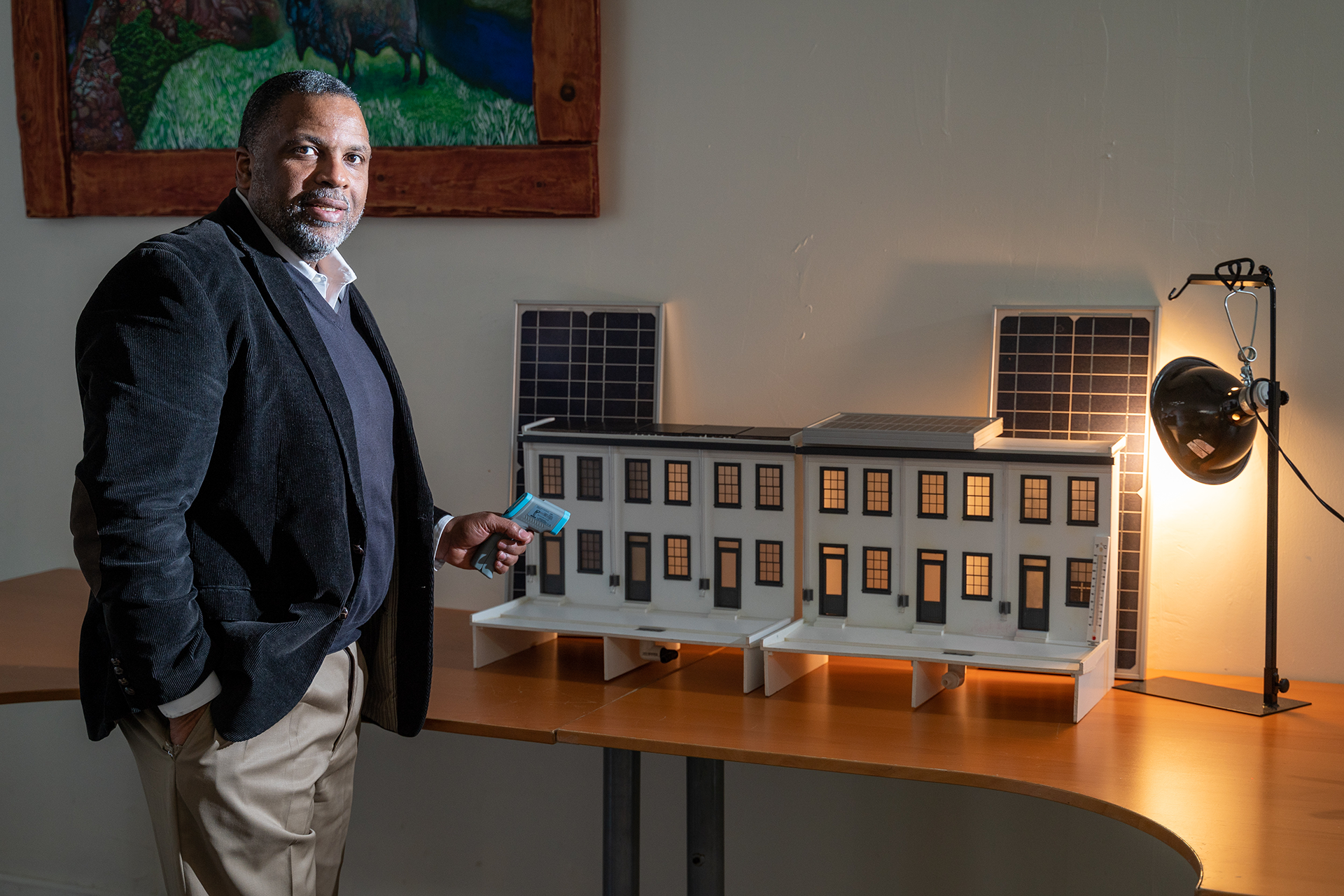
Tangible Connections
Elsewhere in the district, as the curriculum is being dispersed, schools are improving on their greenspaces and using them to deliver some of the hands-on education that Overbrook and Lankenau model. Emma-Lynn Melvin, the green infrastructure program manager for the district, says 42 of its schools now have green stormwater infrastructure, and about 10 new systems will be built this year. Each of them gives students a chance to steward the places where they learn and play, as well as a window into the many ways that sustainability can improve their lives.
The school district has a goal to reach 30% tree canopy on all of its campuses, and the effort to do so ties back directly to the curriculum in the classroom. Melvin describes the greening process and the maintenance it requires as a hands-on part of “a meaningful watershed experience.”
Asphalt schoolyards, where temperatures rise higher without adequate shade, are a microcosm of the challenges of climate change, Melvin says. By planting trees and tending to them over time, students can learn about the benefits of a healthy canopy.
“They’re able to see how the transformation affects the schoolyard and the community,” Melvin says.
Across the district, establishing these tangible connections is just as integral to climate change education as delivering the facts. And once the connections are made, educators are working to help students learn to improve their surroundings.
“Part of my effort is to get kids to be aware that they are part of the solution and also part of the problem,” Melvin says.
Climate change education is “training for life,” Garner says, in that it can connect students to the world around them in meaningful ways.
“We want the graduates from the district to be engaged members of their community and contribute to where they live,” Garner says. “We want them to feel empowered and know that they have a voice and what their options are.”


